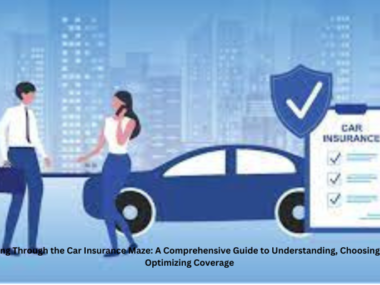Understanding Car Insurance Quotes: A Comprehensive Guide
As a responsible driver, securing reliable and affordable car insurance is a necessity. However, navigating the complex world of car insurance quotes can be a daunting task, with numerous factors and variables to consider. From understanding the different types of coverage to evaluating the factors that influence rates, the process of obtaining accurate quotes can be overwhelming.
In this comprehensive blog post, we’ll delve into the intricacies of car insurance quotes, providing you with the knowledge and insights necessary to make informed decisions and secure the best possible coverage at a fair price. Whether you’re a first-time car owner or an experienced driver seeking to optimize your insurance coverage, this guide will equip you with the tools you need to navigate the car insurance landscape confidently.
Types of Car Insurance Coverage
Before we dive into the nuances of car insurance quotes, it’s essential to understand the various types of coverage available. Car insurance policies typically consist of multiple components, each designed to protect you and your vehicle in different scenarios. Here are some of the most common types of coverage:
Liability Coverage
Liability coverage is typically mandatory in most states and protects you financially if you are found legally responsible for causing bodily injury or property damage to others in an accident. It is divided into two parts:
– Bodily Injury Liability: Covers medical expenses and potential legal fees if you injure someone in an accident.
– Property Damage Liability: Covers repair or replacement costs if you damage someone else’s vehicle or property.
Collision Coverage
Collision coverage helps pay for repairs or replacement of your vehicle if it is damaged in a collision with another vehicle or object, regardless of who is at fault.
Comprehensive Coverage
Comprehensive coverage provides protection against non-collision-related incidents, such as theft, vandalism, weather-related damage (e.g., hail, flood, or falling objects), and animal collisions.
Uninsured/Underinsured Motorist Coverage
This coverage protects you if you are involved in an accident with a driver who does not have insurance or does not have sufficient insurance to cover the damages and injuries.
Additional Coverage Options
Many insurers offer additional coverage options, such as rental car reimbursement, roadside assistance, and gap insurance (for leased or financed vehicles).
Understanding these various coverage types is crucial when obtaining car insurance quotes, as they directly impact the level of protection and the associated costs.
Factors Influencing Car Insurance Rates
Car insurance rates can vary significantly from one driver to another, even for the same vehicle and coverage levels. Several factors contribute to the calculation of insurance premiums, and understanding these factors can help you make informed decisions and potentially lower your rates. Here are some of the key factors that influence car insurance quotes:
Driving History and Record
Your driving record plays a significant role in determining your insurance rates. Insurers consider factors such as traffic violations, accidents, and DUI/DWI convictions when evaluating risk. A clean driving record typically translates to lower premiums, while a history of incidents may result in higher rates.
Age and Experience
Both age and driving experience can impact insurance rates. Younger drivers, especially those under 25, are generally considered higher-risk and may face higher premiums due to their lack of experience. On the other hand, older drivers with years of driving experience and a clean record may qualify for lower rates.
Vehicle Make, Model, and Year
The type of vehicle you drive can significantly influence your insurance rates. Insurers consider factors such as the vehicle’s safety features, repair costs, theft rates, and overall value when calculating premiums. Generally, newer vehicles with advanced safety features and lower repair costs tend to have lower insurance rates compared to older, more expensive vehicles to repair or those with higher theft rates.
Location and Mileage
Where you live and how much you drive can also affect your insurance rates. Urban areas with higher traffic densities and higher rates of accidents and theft typically result in higher premiums. Additionally, drivers who log more miles annually may face higher rates due to increased exposure to potential accidents.
Credit Score
In many states, insurers are permitted to consider your credit score when calculating insurance rates. Statistically, drivers with lower credit scores are more likely to file claims, which can result in higher premiums.
Gender and Marital Status
Depending on your location, gender and marital status may also be factored into insurance rate calculations. Historically, statistics have shown that married individuals and women tend to have fewer accidents and file fewer claims, potentially leading to lower rates.
Coverage Levels and Deductibles
The coverage levels and deductibles you choose will directly impact your insurance rates. Higher coverage limits and lower deductibles typically result in higher premiums, as the insurer assumes more risk. Conversely, lower coverage limits and higher deductibles can reduce your premiums but leave you with more out-of-pocket expenses in the event of a claim.
By understanding these factors and how they influence your insurance rates, you can make informed decisions and potentially adjust certain variables to obtain more favorable quotes.
Obtaining Accurate Car Insurance Quotes
With a solid understanding of the various coverage types and factors influencing insurance rates, the next step is to obtain accurate quotes from multiple insurers. Here are some tips to help you navigate the quote process effectively:
Gather Necessary Information
Before requesting quotes, have all the necessary information at hand, such as your driver’s license number, vehicle details (make, model, year, VIN), driving history, and any existing insurance policies. Providing accurate and complete information will ensure you receive accurate quotes.
Utilize Online Quote Tools
Most insurance companies offer online quote tools that allow you to input your information and receive instant quotes. These tools can be a convenient starting point, but keep in mind that the quotes may be subject to further verification and adjustment based on additional factors.
Speak with Insurance Agents
While online quote tools are convenient, speaking with licensed insurance agents can provide a more personalized experience and allow you to ask questions, clarify details, and receive expert guidance. Agents can also help you understand the nuances of different coverage options and recommend the most suitable plan based on your specific needs.
Compare Quotes from Multiple Insurers
It’s crucial to obtain quotes from multiple insurers to ensure you’re getting the best possible rates. Insurance rates can vary significantly between companies, even for identical coverage levels and driver profiles.
Negotiate and Ask About Discounts
Don’t be afraid to negotiate with insurers or ask about potential discounts. Many companies offer discounts for factors such as bundling policies, good driving records, safety features, or membership in certain organizations. Inquiring about available discounts can help you save money on your premiums.
Review Quotes Thoroughly
Once you receive quotes, review them carefully to ensure you understand the coverage levels, deductibles, and any exclusions or limitations. Don’t hesitate to ask for clarification on anything that is unclear or seems questionable.
Consider Your Specific Needs and Budget
Ultimately, the right car insurance quote for you will depend on your specific needs and budget. While it’s tempting to choose the lowest quote, it’s essential to balance cost with adequate coverage levels to protect yourself and your assets adequately.
By following these steps and taking the time to thoroughly evaluate and compare car insurance quotes, you can increase your chances of securing the best coverage at a fair and reasonable price.
Tips for Lowering Car Insurance Rates
While car insurance is a necessary expense, there are several strategies you can employ to potentially lower your rates and save money without compromising your coverage:
Maintain a Clean Driving Record
One of the most effective ways to keep your insurance rates low is to maintain a clean driving record. Avoid traffic violations, accidents, and other incidents that can negatively impact your rates.
Improve Your Credit Score
If your insurer considers credit scores when calculating rates, improving your credit score can potentially lead to lower premiums. Pay bills on time, reduce outstanding debt, and monitor your credit report regularly.
Bundle Insurance Policies
Many insurers offer discounts for bundling multiple policies, such as auto and homeowners or renters insurance. Consolidating your coverage with a single provider can result in significant savings.
Increase Deductibles
While it’s important to maintain adequate coverage levels, increasing your deductibles can lower your premiums. Consider raising your deductibles to an amount you can comfortably afford in the event of a claim.
Take Advantage of Discounts
Inquire about available discounts and ensure you’re taking advantage of any that apply to you. Common discounts include those for good students, defensive driving courses, safety features, low mileage, and loyalty to the insurer.
Reevaluate Your Coverage Annually
Your insurance needs may change over time, so it’s essential to reevaluate your coverage annually. As your vehicle ages or your circumstances change, you may be able to adjust your coverage levels or deductibles to obtain more favorable rates.
Consider Usage-Based Insurance
Some insurers offer usage-based insurance programs, also known as telematics or pay-as-you-drive insurance. These programs track your driving habits and mileage using a device or mobile app, and those with safe driving behaviors and low mileage can potentially qualify for lower rates.
Shop Around Regularly
The car insurance market is highly competitive, and rates can fluctuate frequently. It’s a good practice to shop around and obtain quotes from multiple insurers annually to ensure you’re still getting the best deal.
Improve Vehicle Safety Features
Installing safety features like anti-lock brakes, airbags, and anti-theft devices can make your vehicle less risky to insure, potentially leading to lower rates. Additionally, choosing a vehicle with a good safety rating can also help reduce your premiums.
Consider Raising Your Credit Limit
In some cases, raising your credit limit can improve your credit utilization ratio, which is a factor that insurers consider when calculating rates. However, be cautious and avoid increasing your credit limits if it may tempt you to accrue more debt.
By implementing these strategies and remaining proactive in managing your car insurance coverage, you can potentially save hundreds or even thousands of dollars over the life of your policy without sacrificing essential protection.
Navigating the Claims Process
Despite our best efforts, accidents can still happen, and understanding the claims process is crucial to ensure you receive the coverage and assistance you need. Here are some key steps to follow when filing a car insurance claim:
Gather Necessary Information
After an accident, gather as much information as possible, including the other driver’s contact and insurance details, witness information, and any relevant documentation or photographs. This information will be necessary when filing your claim.
Report the Incident Promptly
Notify your insurance company about the incident as soon as possible. Most insurers have strict time limits for reporting claims, and delays could potentially jeopardize your coverage.
Cooperate with the Claims Process
Provide your insurer with all the necessary information and documentation they request. Respond promptly to any inquiries or requests for additional details to ensure a smooth claims process.
Understand Your Coverage and Deductibles
Review your policy to understand the coverage limits, deductibles, and any specific exclusions or limitations that may apply to your claim. This will help you manage your expectations and prepare for any out-of-pocket expenses.
Consider Repair Options
Depending on the extent of the damage, your insurer may recommend approved repair facilities or provide a cash settlement for repairs. Evaluate the options and choose the one that best suits your needs and budget.
Stay Organized and Keep Records
Maintain detailed records of all communication, documentation, and expenses related to your claim. This information can be invaluable if any disputes or issues arise during the claims process.
Understand Your Rights and Appeal Process
If you disagree with the insurer’s decision or settlement offer, understand your rights and the appeal process. Many states have consumer protection laws and regulatory bodies that can assist in resolving disputes with insurance companies.
By following these steps and remaining proactive throughout the claims process, you can ensure a smoother experience and increase the likelihood of receiving the coverage and assistance you’re entitled to under your policy.
Conclusion
Navigating the world of car insurance quotes can be a complex and daunting task, but with the right knowledge and approach, you can secure reliable coverage at a fair price. By understanding the various types of coverage, the factors influencing insurance rates, and the strategies for obtaining accurate quotes, you’ll be better equipped to make informed decisions.
Remember, car insurance is not a one-size-fits-all solution. Your specific needs, driving habits, and financial situation will ultimately dictate the coverage levels and premiums that are most suitable for you. Take the time to evaluate your options, compare quotes from multiple insurers, and don’t hesitate to negotiate or seek guidance from licensed insurance professionals.
Ultimately, the goal of car insurance is to provide peace of mind and financial protection in the event of an accident or unexpected incident. By prioritizing adequate coverage and implementing strategies to lower your rates, you can strike a balance between protecting yourself and your assets while minimizing unnecessary expenses.
Stay vigilant, stay informed, and stay protected – with the right car insurance quote, you can hit the road with confidence, knowing that you and your vehicle are covered in the face of life’s uncertainties.





